#IBM financial performance
Explore tagged Tumblr posts
Text
Explore International Business Machines (IBM) stock price forecasts for 2025–2029, diving into financials, dividends, and competitive trends. #InternationalBusinessMachines #IBM #IBMstock #Stockpriceforecast #Dividendyield #Hybridcloud #AItechnology #Investmenttips #Techstocks #Stockmarketanalysis
#AI technology#Best time to buy IBM shares#Competitive Landscape#Dividend Yield#How to invest in IBM stock today#Hybrid cloud#IBM#IBM competitive analysis 2025#IBM dividend yield and buyback policy#IBM financial performance#IBM hybrid cloud and AI growth potential#IBM stock#IBM stock forecast and financial ratios#IBM stock price history and trends#IBM stock price prediction 2025–2029#International Business Machines#Investment#Investment Insights#Investment tips#Is IBM stock a good long-term investment#Should I buy IBM stock in 2025#Stock Forecast#Stock Insights#Stock market analysis#Stock Price Forecast#Tech stocks
0 notes
Text

Dr. Evelyn Boyd Granville (May 1, 1924 - June 27, 2023) was the second African American woman to receive a Ph.D. in mathematics from an American University; she earned it from Yale University. She performed pioneering work in the field of computing.
She entered Smith College. She majored in mathematics and physics but also took a keen interest in astronomy. She was elected to Phi Beta Kappa and Sigma Xi and graduated summa cum laude. Encouraged by a graduate scholarship from the Smith Student Aid Society of Smith College, she applied to graduate programs in mathematics and was accepted by both Yale University and the University of Michigan; she chose Yale because of the financial aid they offered. She studied functional analysis, finishing her doctorate. Her dissertation was “On Laguerre Series in the Complex Domain”.
She moved from Washington to New York City. She moved to Los Angeles. There she worked for the US Space Technology Laboratories, which became the North American Aviation Space and Information Systems Division. She worked on various projects for the Apollo program, including celestial mechanics, trajectory computation, and “digital computer techniques”.
Forced to move because of restructuring at IBM, she took a position at California State University, Los Angeles as a full professor of mathematics. After retiring from CSULA she taught at Texas College for four years and then joined the faculty of the University of Texas at Tyler as the Sam A. Lindsey Professor of Mathematics. There she developed elementary school math enrichment programs. She has remained a strong advocate for women’s education in tech. #africanhistory365 #africanexcellence #phibetakappa
10 notes
·
View notes
Text
D-Wave Quantum News Stock Rises 1300% in 12 Months

D-Wave Quantum News
Zacks analyst blog highlights Rigetti, IBM, IonQ, and D-wave quantum computing.
Investors are interested in D-Wave Quantum because to its 1359.5% share price growth over the past year. This remarkable gain has been fueled by the company's good quarterly financial results, the AI-driven infrastructure boom, and rising quantum technology demand.
The recent quantum computational superiority of D-Wave boosts its confidence and commercial differentiation. In the first quarter of 2025, D-Wave solved a real-world materials science problem and published results in Science. A top-tier classical supercomputer would have needed a million years and more energy than the world to solve a problem D-Wave's 1,200-qubit Advantage2 prototype solved in a year. IonQ and Rigetti Computing, which are unprofitable, behind D-Wave.
Annealing quantum computing, a subfield of computing that is ideal for combinatorial and optimisation tasks, is D-Wave's specialisation. The growing range of production applications shows that D-Wave devices are instant-deployable. Unlike many of its competitors, which focus on gate-based approaches in development.
D-Wave Quantum appears financially stable, which will help it profit. The corporation had a record $304.3 million cash balance in the first quarter of 2025. The quarter's $146.2 million nett proceeds from its third At-The-Market (ATM) issuance strengthened its financial position.
D-Wave's management is confident that this large cash reserve will fund operations until profitability, making the company one of the most capital-efficient in quantum computing. Technology helps D-Wave Quantum succeed. The market trusts the company's financial health and future prospects because its 50-day SMA routinely exceeds its 200-day SMA. D-Wave Quantum's second-quarter and full-year 2025 earnings are expected to rise 72% and 30%, respectively, according to Zacks.
The audacious quantum computing project by IBM has renewed competition. IBM's new Quantum Starling, a large-scale, fault-tolerant quantum computer that can perform 20,000 times more operations than existing machines, challenges the market. In its broad roadmap, IBM plans to provide modular scalability and fault tolerance by the end of the decade. IBM's planned move demonstrates its long-term ambition of leading corporate quantum technology, but also raises problems for smaller startups like D-Wave Quantum.
D-Wave Quantum appears to be able to withstand competition even with IBM's renewed effort. The company's singular achievement of real-world quantum supremacy, confirmed by a peer-reviewed Science paper, distinguishes it from competitors that focus on gate-based systems with fewer commercial deployments. D-Wave's production-ready annealing solutions are already targeting a bigger market, so IBM's large quantum technology investment is intriguing.
Zacks.com believes that D-Wave has a large growth runway despite IBM's quantum race entry. D-Wave Quantum may provide longer-term investors more upside due to its strong first-quarter 2025 performance, rising business usage, and Zacks Rank #2 (Buy).
To conclude
This June 2025 Zacks Analyst Blog highlights D-Wave Quantum (QBTS) and IBM, two quantum computer companies seeing tremendous growth. D-Wave's stock performance and quantum dominance in addressing a difficult materials science problem set it apart from rivals like IonQ and Rigetti Computing. IBM's planned effort to join quantum computing's next step with Quantum Starling may make it difficult for smaller firms like D-Wave to compete.
Even while IBM's developments demonstrate the market's promise, the blog believes D-Wave's unique annealing technology, stable financial position, and recent operational successes position it for growth despite increased competition. The research concludes that D-Wave's fundamentals and market position suggest more upside.
#DWaveQuantumNews#IonQ#RigettiComputing#IBMQuantumStarling#DWave#News#Technews#Technology#Technologynews#Technologytrends#Govindhtech
0 notes
Text
Unlocking the Future: A Comprehensive Guide to B Tech in IoT

The world is becoming smarter—our homes, cities, industries, and even healthcare systems are being transformed by the Internet of Things (IoT). With the rapid evolution of connected devices and smart systems, a B Tech in IoT is one of the most promising career pathways for technology-driven students. This 4-year undergraduate program prepares students to innovate, design, and implement smart technologies that improve the way we live and work.
What is B Tech in IoT?
A B Tech in IoT (Internet of Things) is a specialized engineering program focusing on designing and developing systems where devices are interconnected via the internet to share and analyze data. The course blends elements of electronics, computer science, networking, cloud computing, and machine learning to create smart solutions for real-world problems.
Students learn to build embedded systems, design smart sensors, develop communication protocols, and understand cloud-based analytics—all critical skills in a hyper-connected digital world.
youtube
B Tech IoT Admission: How to Get in?
The B Tech IoT admission process typically begins with entrance exams or merit-based evaluations. Top engineering colleges in India, including private universities, consider scores from exams such as JEE Main, state-level CETs, or university-level entrance tests.
Some universities also offer direct B Tech IoT admission based on Class 12 performance or through management quota. Students must keep track of admission dates, application deadlines, and counseling procedures to secure a seat in this competitive program.
Pro tip: Focus on subjects like Physics, Chemistry, and Mathematics in your Class 12 board exams, and consider preparing early for entrance exams.
B Tech IoT Eligibility: Who Can Apply?
The B Tech IoT eligibility criteria vary slightly across institutions but generally include:
Completion of 10+2 or equivalent examination with Physics, Mathematics, and Chemistry/Computer Science.
Minimum aggregate marks of 50-60% (varies by university).
A valid score in a relevant entrance exam (if applicable).
Students from technical backgrounds with a flair for innovation, coding, and problem-solving are ideal candidates for this program. The course is designed for those who are passionate about emerging technologies and aspire to lead the future of automation and intelligent systems.
B Tech IoT Fees: What’s the Investment?
When considering any higher education program, understanding the cost is crucial. B Tech IoT fees depend on the institution, location, infrastructure, and other facilities offered. Here's a general breakdown:
Private Universities: ₹1.5 to ₹2.5 lakhs per annum
Government Colleges: ₹50,000 to ₹1 lakh per annum
Additional Costs: Lab fees, hostel accommodation, exam fees, and project expenses.
Some institutions offer scholarships for meritorious students or financial aid for economically weaker sections. Many universities also collaborate with industries for sponsored research projects, which sometimes include stipends.
B Tech IoT Placements: Career After Graduation
One of the biggest attractions of this course is the excellent B Tech IoT placement prospects. As IoT is being adopted across industries, companies are on the lookout for skilled professionals who can drive smart innovation.
Top Recruiters:
Tata Consultancy Services (TCS)
Infosys
Wipro
Bosch
Intel
Cisco
IBM
Tech Mahindra
HCL
Amazon Web Services (AWS)
Roles You Can Pursue:
IoT Software Developer
Embedded Systems Engineer
IoT Solution Architect
Cloud Engineer
Data Analyst
Network Engineer
Smart Device Tester
Product Manager – IoT
Average starting packages range from ₹4 LPA to ₹10 LPA, with higher salaries for roles in R&D, international placements, or MNCs. With a few years of experience, IoT professionals often move into leadership or consulting roles, commanding even higher salaries.
Final Thoughts: Is B Tech in IoT Worth It?
If you're excited about automation, connectivity, and innovation, a B Tech in IoT can open doors to a dynamic and impactful career. From developing smart homes to revolutionizing healthcare and industrial automation, IoT professionals play a vital role in shaping the digital future.
Before applying, ensure you meet the B Tech IoT eligibility criteria, compare B Tech IoT fees across universities, and consider the potential return on investment through B Tech IoT placements. With the right skills and exposure, you'll not only be employable but also future-ready in an ever-evolving tech landscape.
0 notes
Text
DBMS Tutorial Explained: Concepts, Types, and Applications

In today’s digital world, data is everywhere — from social media posts and financial records to healthcare systems and e-commerce websites. But have you ever wondered how all that data is stored, organized, and managed? That’s where DBMS — or Database Management System — comes into play.
Whether you’re a student, software developer, aspiring data analyst, or just someone curious about how information is handled behind the scenes, this DBMS tutorial is your one-stop guide. We’ll explore the fundamental concepts, various types of DBMS, and real-world applications to help you understand how modern databases function.
What is a DBMS?
A Database Management System (DBMS) is software that enables users to store, retrieve, manipulate, and manage data efficiently. Think of it as an interface between the user and the database. Rather than interacting directly with raw data, users and applications communicate with the database through the DBMS.
For example, when you check your bank account balance through an app, it’s the DBMS that processes your request, fetches the relevant data, and sends it back to your screen — all in milliseconds.
Why Learn DBMS?
Understanding DBMS is crucial because:
It’s foundational to software development: Every application that deals with data — from mobile apps to enterprise systems — relies on some form of database.
It improves data accuracy and security: DBMS helps in organizing data logically while controlling access and maintaining integrity.
It’s highly relevant for careers in tech: Knowledge of DBMS is essential for roles in backend development, data analysis, database administration, and more.
Core Concepts of DBMS
Let’s break down some of the fundamental concepts that every beginner should understand when starting with DBMS.
1. Database
A database is an organized collection of related data. Instead of storing information in random files, a database stores data in structured formats like tables, making retrieval efficient and logical.
2. Data Models
Data models define how data is logically structured. The most common models include:
Hierarchical Model
Network Model
Relational Model
Object-Oriented Model
Among these, the Relational Model (used in systems like MySQL, PostgreSQL, and Oracle) is the most popular today.
3. Schemas and Tables
A schema defines the structure of a database — like a blueprint. It includes definitions of tables, columns, data types, and relationships between tables.
4. SQL (Structured Query Language)
SQL is the standard language used to communicate with relational DBMS. It allows users to perform operations like:
SELECT: Retrieve data
INSERT: Add new data
UPDATE: Modify existing data
DELETE: Remove data
5. Normalization
Normalization is the process of organizing data to reduce redundancy and improve integrity. It involves dividing a database into two or more related tables and defining relationships between them.
6. Transactions
A transaction is a sequence of operations performed as a single logical unit. Transactions in DBMS follow ACID properties — Atomicity, Consistency, Isolation, and Durability — ensuring reliable data processing even during failures.
Types of DBMS
DBMS can be categorized into several types based on how data is stored and accessed:
1. Hierarchical DBMS
Organizes data in a tree-like structure.
Each parent can have multiple children, but each child has only one parent.
Example: IBM’s IMS.
2. Network DBMS
Data is represented as records connected through links.
More flexible than hierarchical model; a child can have multiple parents.
Example: Integrated Data Store (IDS).
3. Relational DBMS (RDBMS)
Data is stored in tables (relations) with rows and columns.
Uses SQL for data manipulation.
Most widely used type today.
Examples: MySQL, PostgreSQL, Oracle, SQL Server.
4. Object-Oriented DBMS (OODBMS)
Data is stored in the form of objects, similar to object-oriented programming.
Supports complex data types and relationships.
Example: db4o, ObjectDB.
5. NoSQL DBMS
Designed for handling unstructured or semi-structured data.
Ideal for big data applications.
Types include document, key-value, column-family, and graph databases.
Examples: MongoDB, Cassandra, Redis, Neo4j.
Applications of DBMS
DBMS is used across nearly every industry. Here are some common applications:
1. Banking and Finance
Customer information, transaction records, and loan histories are stored and accessed through DBMS.
Ensures accuracy and fast processing.
2. Healthcare
Manages patient records, billing, prescriptions, and lab reports.
Enhances data privacy and improves coordination among departments.
3. E-commerce
Handles product catalogs, user accounts, order histories, and payment information.
Ensures real-time data updates and personalization.
4. Education
Maintains student information, attendance, grades, and scheduling.
Helps in online learning platforms and academic administration.
5. Telecommunications
Manages user profiles, billing systems, and call records.
Supports large-scale data processing and service reliability.
Final Thoughts
In this DBMS tutorial, we’ve broken down what a Database Management System is, why it’s important, and how it works. Understanding DBMS concepts like relational models, SQL, and normalization gives you the foundation to build and manage efficient, scalable databases.
As data continues to grow in volume and importance, the demand for professionals who understand database systems is also rising. Whether you're learning DBMS for academic purposes, career development, or project needs, mastering these fundamentals is the first step toward becoming data-savvy in today’s digital world.
Stay tuned for more tutorials, including hands-on SQL queries, advanced DBMS topics, and database design best practices!
0 notes
Text
Quantum Computing Cloud Service Market Growth 2025
The Quantum Computing Cloud Service Market refers to a specialized sector within the broader quantum technology ecosystem that offers access to quantum computing resources via cloud platforms. These services enable enterprises, research institutions, and developers to run quantum algorithms, perform simulations, and conduct experiments without needing physical quantum hardware on-premises. Quantum cloud services combine classical computing infrastructure with quantum processors, simulators, or hybrid systems to solve complex computational problems across industries such as finance, pharmaceuticals, logistics, and artificial intelligence.
Get free sample of this report at : https://www.intelmarketresearch.com/energy-and-natural-resources/914/Quantum-Computing-Cloud-Servic-Market
Market Size
As of 2024, the global Quantum Computing Cloud Service market is valued at US$ 422.6 million, with a robust CAGR of 27.52% projected over the forecast period (2024–2030). By 2030, the market is expected to reach a substantial size of US$ 1.81 billion. This remarkable growth trajectory is fueled by increasing investments from both public and private sectors, rising demand for high-performance computing, and advancements in quantum algorithms and hardware integration.

The global Quantum Computing Cloud Service Market is rapidly gaining momentum as organizations across industries seek scalable, on-demand access to quantum resources without the need for in-house quantum hardware. This shift is being fueled by the growing realization that quantum computing can solve complex problems such as molecular simulation, cryptography, and optimization that are beyond the reach of classical computers.As of 2024, IBM, Amazon Web Services (AWS), Microsoft Azure Quantum, and Google Cloud are leading the charge by offering cloud-based quantum computing platforms, enabling researchers and enterprises to experiment with quantum algorithms in real-time.
Historical analysis suggests that the early 2020s were pivotal in mainstream adoption due to the democratization of access to quantum processing units (QPUs) via cloud-based interfaces. Cloud platforms like IBM Quantum Experience, Amazon Braket, and Microsoft Azure Quantum significantly lowered the entry barriers, allowing non-specialist users to engage with quantum computing for prototyping and research.
Industry verticals such as pharmaceutical R&D, financial modeling, supply chain optimization, and machine learning are early adopters pushing the demand envelope for commercial quantum computing.
Market Dynamics (Drivers, Restraints, Opportunities, and Challenges)
Drivers
Surging Need for High-Performance Computing
The rising demand for high-performance computing across sectors like finance, healthcare, and logistics is fueling the quantum computing cloud service market. Quantum cloud platforms allow real-time access to powerful systems without heavy infrastructure costs. For example, Telefónica Germany is piloting quantum-based network optimization with AWS Braket. In healthcare, quantum models accelerate drug discovery, while financial firms use them for complex portfolio optimization. Cloud-based quantum services from IBM, Microsoft, and Amazon are democratizing this technology, driving rapid market growth
Companies like IBM and PsiQuantum are investing heavily in quantum computing. IBM has committed $150 billion over five years to support domestic manufacturing and advance quantum computing technology . PsiQuantum raised $750 million in March 2025 to develop a fault-tolerant quantum computer.
Restraints
Limited Quantum Hardware Maturity and High Error Rates
The immaturity of quantum hardware and persistent error rates in quantum computations are two significant barriers to the market for cloud services for quantum computing. Current quantum systems, referred to as Noisy Intermediate-Scale Quantum (NISQ) devices, have unstable outputs and limited practical use due to their extreme sensitivity to environmental interference. For example, even though Google and IBM have demonstrated quantum supremacy, these systems still need a lot of error correction, which prevents them from being used in many practical situations. Furthermore, scalability is hampered by short coherence times and limited qubit counts. Despite cloud-based accessibility and growing enterprise interest, adoption is slowed by this technological bottleneck.
Opportunities
Expansion of Hybrid Quantum-Classical Computing Solutions
The integration of quantum computing with classical cloud infrastructure presents a significant opportunity to accelerate practical applications.Hybrid quantum-classical systems increase overall efficiency by allowing users to use classical processors for routine tasks and quantum algorithms for complex problem-solving. One platform that supports this hybrid model is Microsoft Azure Quantum, which enables developers to seamlessly combine the two computing types. By increasing speed and accuracy, this method overcomes the limitations of current quantum hardware. To improve drug discovery, portfolio management, and supply chain operations, sectors like pharmaceuticals, finance, and logistics are progressively implementing hybrid solutions. This is driving market expansion and the commercialization of quantum technologies.
Challenges
Data Security and Privacy Concerns
As quantum computing cloud services handle sensitive and proprietary data, data security and privacy have become critical challenges. The transfer of data to cloud platforms raises concerns about potential breaches and unauthorized access, especially as quantum technologies could eventually break traditional encryption methods. Organizations remain cautious about migrating critical workloads without robust security frameworks tailored for quantum environments. Ensuring secure quantum key distribution (QKD) and developing quantum-resistant cryptographic standards are still evolving fields, delaying broader trust and adoption of quantum cloud services across industries like finance and healthcare.
Regional Analysis
North America currently leads the quantum computing cloud service market, fueled by substantial investments, strong R&D infrastructure, and early adoption by tech giants like IBM, Microsoft, and Google. The National Quantum Initiative Act of the US government has further spurred innovation, allowing businesses to provide cutting-edge quantum cloud platforms on a broad scale. For instance, the U.S.-based IBM Quantum Experience offers access to several quantum processors, drawing users from all over the world.Due to growing government support and developing technology ecosystems in nations like China, Japan, and South Korea, Asia-Pacific is currently the region with the fastest rate of growth. Strong regional momentum is shown by projects like Alibaba Cloud's quantum computing services and China's National Quantum Laboratory. Furthermore, the region's growing academic-industry partnerships are propelling the development and commercialization of quantum cloud solutions.The European Quantum Flagship program, which provides funding for extensive quantum research and innovation, has helped Europe establish a strong position. However, its growth is moderate due to slower commercialization than in North America and Asia-Pacific..Emerging markets in Latin America and the Middle East & Africa are gradually exploring quantum computing, primarily through partnerships and pilot projects, setting the stage for future expansion as infrastructure and expertise improve.
Competitor Analysis
IBM: A pioneer with its IBM Quantum Experience, offering access to superconducting qubits through its Qiskit SDK.
Google: Achieved quantum supremacy in 2019 and continues to develop the Sycamore processor.
Microsoft: Offers Azure Quantum with hybrid cloud access and integrations with Honeywell and IonQ.
Amazon: Operates Amazon Braket, providing access to various quantum backends including D-Wave, IonQ, and Rigetti.
Huawei and Alibaba Cloud: Focused on integrating quantum computing into broader cloud ecosystems in Asia.
Startups like Rigetti Computing, Xanadu, QuTech, and Strangeworks are also playing key roles in commercializing and democratizing access to quantum resources.
May 2025, L&T-Cloudfiniti has forged a strategic partnership with Bengaluru-based deep-tech company QpiAI. The collaboration will focus on driving quantum computing workloads, including Quantum Computing as a Service (QCAAS), enabling scalable deployment of quantum solutions across domains.
March 2024, NVIDIA announced the launched a cloud service that allows researchers and developers to push the boundaries of quantum computing exploration in key scientific domains, including chemistry, biology and materials science.
November, 2023, Amazon Web Services launched Braket Direct, a service that enables researchers to purchase private, dedicated access to quantum processing units from companies like Amazon Quantum Solutions Lab, QuEra, Oxford Quantum Circuits, IonQ, or Rigetti.
April 2023, Moderna, Inc.a biotechnology company pioneering messenger RNA (mRNA) therapeutics and vaccines, and IBM announced an agreement under which Moderna will explore next generation technologies including quantum computing and artificial intelligence to advance and accelerate mRNA research and science.
November, 2023 Microsoft announce a strategic co-innovation collaboration with Photonics Inc , a company focused on building scalable, fault tolerant, and distributed quantum technologies.With this collobrotion the company aims to unlock the next stages in quantum networking and empower the quantum computing ecosystem with new capabilities enabled by its unique and complementary approaches to scalable quantum infrastructure.
Global Quantum Computing Cloud Service Market: Market Segmentation Analysis
This report provides a deep insight into the global Quantum Computing Cloud Service market, covering all its essential aspects. This ranges from a macro overview of the market to micro details of the market size, competitive landscape, development trend, niche market, key market drivers and challenges, SWOT analysis, value chain analysis, etc.
The analysis helps the reader to shape the competition within the industries and strategies for the competitive environment to enhance the potential profit. Furthermore, it provides a simple framework for evaluating and assessing the position of the business organization. The report structure also focuses on the competitive landscape of the Global Quantum Computing Cloud Service Market. This report introduces in detail the market share, market performance, product situation, operation situation, etc., of the main players, which helps the readers in the industry to identify the main competitors and deeply understand the competition pattern of the market.
In a word, this report is a must-read for industry players, investors, researchers, consultants, business strategists, and all those who have any kind of stake or are planning to foray into the Quantum Computing Cloud Service market in any manner.
Market Segmentation (by Service Type)
Quantum Computing as a Service (QCaaS)
Hybrid Quantum-Classical Computing Services
Quantum Software Development Kits (SDKs) & APIs
Quantum Machine Learning (QML) Services
Market Segmentation (by Deployment)
On Premises
Cloud
Market Segmentation (by Application)
Financial Modeling
Artificial Intelligence
Climate Modeling & Energy Research
Drug Discovery & Material Science
Other
Market Segmentation (by End Use Industry)
Banking, Financial Services & Insurance (BFSI)
Healthcare & Pharmaceuticals
Energy & Utilities
Automotive & Aerospace
Government & Defense
Academic & Research Institutions
IT & Telecommunications
Key Company
Microsoft
Google
Amazon
IBM
Huawei
Rigetti Computing
D-Wave Leap
Xanadu Quantum Cloud
Honeywell
QuTech
Strangeworks
Geographic Segmentation
North America (USA, Canada, Mexico)
Europe (Germany, UK, France, Russia, Italy, Rest of Europe)
Asia-Pacific (China, Japan, South Korea, India, Southeast Asia, Rest of Asia-Pacific)
South America (Brazil, Argentina, Columbia, Rest of South America)
The Middle East and Africa (Saudi Arabia, UAE, Egypt, Nigeria, South Africa, Rest of MEA)
FAQ Section :
▶ What is the current market size of Quantum Computing Cloud Service?
The market was valued at US$ 422.6 million in 2024 and is projected to reach US$ 1.81 billion by 2030, growing at a CAGR of 27.52%.
▶ Which are the key companies operating in the Quantum Computing Cloud Service market?
Key players include IBM, Microsoft, Amazon, Google, Huawei, Honeywell, Rigetti Computing, and Xanadu, among others.
▶ What are the key growth drivers in the Quantum Computing Cloud Service market?
Growth is driven by increased R&D investment, scalable cloud infrastructure, hybrid computing models, and the demand for high-performance quantum resources.
▶ Which regions dominate the Quantum Computing Cloud Service market?
North America leads, followed by Europe and Asia-Pacific. The U.S., Germany, China, and Japan are key countries.
▶ What are the emerging trends in the Quantum Computing Cloud Service market?
Trends include the rise of hybrid quantum-classical systems, Quantum-as-a-Service (QaaS) models, and cross-industry collaborations in finance, pharma, and logistics.
Get free sample of this report at : https://www.intelmarketresearch.com/energy-and-natural-resources/914/Quantum-Computing-Cloud-Servic-Market
0 notes
Text
Automated Testing Software Market Global Industry Analysis | Trends 2025-2033

The Reports and Insights, a leading market research company, has recently releases report titled “Automated Testing Software Market: Global Industry Trends, Share, Size, Growth, Opportunity and Forecast 2025-2033.” The study provides a detailed analysis of the industry, including the global Automated Testing Software Market share, size, trends, and growth forecasts. The report also includes competitor and regional analysis and highlights the latest advancements in the market.
Report Highlights:
How big is the Automated Testing Software Market?
The global automated testing software market was valued at US$ 6.6 billion in 2024 and is expected to register a CAGR of 7.4% over the forecast period and reach US$ 12.6 billion in 2033.
What are Automated Testing Software?
Automated testing software comprises tools and frameworks created to automate the running of tests for software applications. It enables developers and quality assurance teams to efficiently test software functionality, performance, and security by executing pre-scripted tests. This software can mimic user interactions, detect bugs and errors, and provide comprehensive reports on test outcomes. Its use enhances testing speed and accuracy, resulting in quicker development cycles and improved software quality.
Request for a sample copy with detail analysis: https://www.reportsandinsights.com/sample-request/1735
What are the growth prospects and trends in the Automated Testing Software industry?
The automated testing software market growth is driven by various factors and trends. The market for automated testing software is experiencing rapid expansion within the software industry, propelled by the widespread adoption of agile and DevOps methodologies. This market encompasses a range of tools and platforms aimed at automating testing processes, enhancing software quality, and expediting time-to-market. Key drivers of market growth include the increasing requirement for continuous testing, the imperative to cut down testing expenses and time, and the escalating complexity of software applications. Additionally, the market is influenced by the escalating trend of digital transformation across industries, which necessitates dependable testing solutions to ensure software applications' reliability and performance. Hence, all these factors contribute to automated testing software market growth.
What is included in market segmentation?
The report has segmented the market into the following categories:
By Type of Testing:
Functional Testing
Performance Testing
Security Testing
Compatibility Testing
Usability Testing
Others
By Testing Tool:
Test Management Tools
Functional Testing Tools
Performance Testing Tools
Security Testing Tools
Codeless Testing Tools
Others
By Deployment Mode:
On-Premises
Cloud-based
By Organization Size:
Small and Medium-sized Enterprises (SMEs
Large Enterprises
By End-User Industry:
IT and Telecom
BFSI (Banking, Financial Services, and Insurance)
Healthcare
Retail
Manufacturing
Government and Public Sector
Media and Entertainment
Others
Segmentation By Region:
North America:
United States
Canada
Europe:
Germany
The U.K.
France
Spain
Italy
Russia
Poland
BENELUX
NORDIC
Rest of Europe
Asia Pacific:
China
Japan
India
South Korea
ASEAN
Australia & New Zealand
Rest of Asia Pacific
Latin America:
Brazil
Mexico
Argentina
Middle East & Africa:
Saudi Arabia
South Africa
United Arab Emirates
Israel
Who are the key players operating in the industry?
The report covers the major market players including:
IBM Corporation
SmartBear Software
Tricentis
Ranorex GmbH
TestComplete
Selenium
Appium
Sauce Labs Inc.
Parasoft Corporation
Eggplant (formerly TestPlant)
Cigniti Technologies
QualiTest Group
Broadcom Inc. (formerly CA Technologies)
Hewlett Packard Enterprise (HPE)
View Full Report: https://www.reportsandinsights.com/report/Automated Testing Software-market
If you require any specific information that is not covered currently within the scope of the report, we will provide the same as a part of the customization.
About Us:
Reports and Insights consistently mееt international benchmarks in the market research industry and maintain a kееn focus on providing only the highest quality of reports and analysis outlooks across markets, industries, domains, sectors, and verticals. We have bееn catering to varying market nееds and do not compromise on quality and research efforts in our objective to deliver only the very best to our clients globally.
Our offerings include comprehensive market intelligence in the form of research reports, production cost reports, feasibility studies, and consulting services. Our team, which includes experienced researchers and analysts from various industries, is dedicated to providing high-quality data and insights to our clientele, ranging from small and medium businesses to Fortune 1000 corporations.
Contact Us:
Reports and Insights Business Research Pvt. Ltd. 1820 Avenue M, Brooklyn, NY, 11230, United States Contact No: +1-(347)-748-1518 Email: [email protected] Website: https://www.reportsandinsights.com/ Follow us on LinkedIn: https://www.linkedin.com/company/report-and-insights/ Follow us on twitter: https://twitter.com/ReportsandInsi1
#Automated Testing Software Market share#Automated Testing Software Market size#Automated Testing Software Market trends
0 notes
Text
Don't Get Stuck! Pick the Best Cloud Provider
Introduction
Choosing the right cloud provider is a crucial decision for businesses looking to leverage cloud-based services. With so many options available, making the wrong choice can lead to unnecessary costs, security risks, and compatibility issues. In this guide, we'll walk you through the essential factors to consider when selecting a cloud provider while incorporating key aspects such as cloud migration service providers, cloud-based AI benefits, cloud computing testing, and more.
Explain Cloud Computing and Its Types
Before diving into how to pick the best cloud provider, it’s important to understand cloud computing and its types. Cloud computing refers to the delivery of computing services—including servers, storage, databases, networking, software, and analytics—over the internet. Instead of maintaining physical servers, businesses can use cloud based service to enhance scalability, security, and efficiency.
There are three primary types of cloud computing:
Public Cloud
Public clouds are provided by third-party vendors like AWS, Microsoft Azure, and Google Cloud. They offer vast scalability and cost-effectiveness since businesses only pay for the resources they use. The infrastructure is shared among multiple clients, making it a suitable option for startups and businesses that require agility. However, public clouds may pose security and compliance challenges, especially for organizations handling sensitive data, such as financial institutions or healthcare providers.
Private Cloud
A private cloud is dedicated solely to a single organization. This model offers enhanced security, better control over infrastructure, and greater customization options. Businesses that handle confidential information, such as government agencies and enterprises dealing with intellectual property, often opt for private clouds. However, private clouds require significant investments in hardware, software, and maintenance, making them a more expensive option.
Hybrid Cloud
A hybrid cloud combines the benefits of both public and private clouds. Organizations can keep sensitive data in a private cloud while using the public cloud for non-sensitive operations. This model provides flexibility, cost optimization, and enhanced security. Companies that require regulatory compliance but also seek scalability and efficiency often choose hybrid cloud solutions.
Evaluating Cloud Migration Service Providers
When shifting to the cloud, selecting the right cloud migration service providers is critical. These providers assist businesses in transferring their on-premises infrastructure, applications, and data to the cloud. Here are some key factors to consider when choosing a migration service provider:
Experience and Expertise – Ensure the provider has a proven track record in handling complex migrations. Providers with experience in your industry are preferable as they understand industry-specific challenges.
Security Measures – The provider should offer strong encryption, compliance with industry regulations, and robust security protocols to protect data during the migration process.
Downtime Minimization – A good provider will ensure minimal disruption during migration, implementing strategies like phased migration and real-time monitoring.
Post-Migration Support – Look for providers that offer ongoing support and optimization after the migration is complete. This includes performance tuning, cost management, and troubleshooting.
Leading Cloud Migration Service Providers
Some of the top cloud migration service providers include:
AWS Migration Services – Offers a suite of migration tools for database migration, application migration, and hybrid cloud management.
Google Cloud Migration – Provides seamless migration tools with AI-driven insights to optimize workloads.
Microsoft Azure Migrate – Helps organizations transition to the cloud with integrated assessments and migration tools.
IBM Cloud Migration Services – Focuses on secure and compliant cloud migration, especially for enterprise applications.
Key Factors to Consider When Choosing a Cloud Provider
Selecting the best cloud provider requires evaluating several key factors:
1. Performance & Reliability
A cloud provider should guarantee high availability and minimal downtime. Check for service-level agreements (SLAs) that promise uptime of at least 99.9%. Look for features like load balancing, redundant servers, and failover mechanisms that ensure seamless performance.
2. Security & Compliance
Security is a top priority for businesses moving to the cloud. Your cloud provider should offer data encryption, firewalls, identity and access management (IAM), and continuous monitoring. Compliance with industry standards such as GDPR, HIPAA, and ISO 27001 ensures that your cloud provider adheres to the highest security and data protection standards.
3. Cost & Pricing Models
Cloud providers offer different pricing models. The pay-as-you-go model charges businesses based on actual usage, while reserved instances provide discounts for long-term commitments. Businesses should analyze their workload requirements to select the most cost-effective model.
4. Scalability & Flexibility
Your cloud provider should offer auto-scaling capabilities to handle traffic spikes and workload fluctuations. Look for features like container orchestration (Kubernetes) and serverless computing to improve efficiency.
5. Integration & Compatibility
Ensure that your cloud platform is compatible with existing software and third-party applications. Popular integrations include SAP, Oracle, Microsoft 365, and DevOps tools.
6. Support & Customer Service
Round-the-clock technical support is essential for addressing cloud-related issues. Some providers offer dedicated account managers, live chat, and community forums for customer assistance.
Benefits of Cloud-Based AI
Artificial Intelligence (AI) is transforming industries, and cloud-based AI offers several advantages:
Cost-Effective AI Models – Cloud AI services eliminate the need for expensive hardware and provide pre-built machine learning models.
Scalability – AI workloads can scale up or down based on demand, reducing costs for businesses.
Real-Time Data Processing – AI models hosted in the cloud process data faster, enabling businesses to make informed decisions.
Pre-Built AI Tools – Cloud providers offer AI-driven solutions such as AWS SageMaker, Google AI, and Azure AI, which allow businesses to deploy AI without needing in-house expertise.
Industries Benefiting from Cloud-Based AI
Healthcare – AI-powered cloud solutions improve diagnosis accuracy, medical image analysis, and patient monitoring.
Finance – Cloud AI helps detect fraud, automate trading, and enhance customer service.
Retail – AI-driven recommendation engines improve customer engagement and sales.
Cloud Computing Testing: Ensuring Performance & Security
Cloud computing testing is essential to validate the functionality, security, and performance of cloud applications. It involves:
Load Testing – Checking how the system handles high user traffic and preventing crashes.
Security Testing – Identifying vulnerabilities in cloud-based applications and implementing threat detection mechanisms.
Performance Testing – Evaluating response times, speed, and resource utilization to ensure smooth operations.
Popular Cloud Testing Tools
Apache JMeter – Open-source tool for performance and load testing.
LoadRunner – Helps test application behavior under different load conditions.
Selenium – Automates cloud-based testing for web applications.
Conclusion
Choosing the best cloud provider is crucial for businesses looking to maximize efficiency and innovation. By evaluating cloud migration service providers, understanding cloud computing types, leveraging Benefits of Cloud Based AI, and conducting proper cloud computing testing, organizations can make informed decisions and avoid getting stuck with the wrong provider.
Take your time, assess your needs, and pick the cloud provider that best aligns with your business goals!
0 notes
Link
#cloudcomputing#cloudmigration#CostOptimization#datasovereignty#digitaltransformation#Enterprisetechnology#hybridcloud#ITInfrastructure
0 notes
Text

↑ IBM Business Analytics defined and pursued an exciting roadmap to reinvention, largely through a close collaboration between design and product management. Lead by strategic design, we introduced frameworks such as Jobs-To-Be-Done, 3 Horizons, Value Proposition Canvas, and Design Envisioning Sprints for a portfolio of 4 flagship products: Planning Analytics, Cognos Analytics, Controller, and Open Pages. The outcome was to future-proof these products by integrating an end-to-end business performance management cycle for our customers, using emerging technologies such as AI where they made an impact.
IBM Business Analytics

↑ The business performance management cycle for extended financial planning analytics, connects business intelligence and business planning together with data.
↓ Traditional business analytics solutions target 8-10% of an organization's technically advanced users, but knowledge workers represent 60% of xFPA consumption.
↘ Rising need for organizations to make better decisions quickly and easily from increasingly complex data requires us to rethink traditionally technical modes of BI tools.
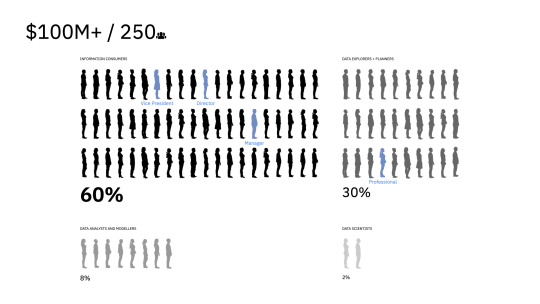
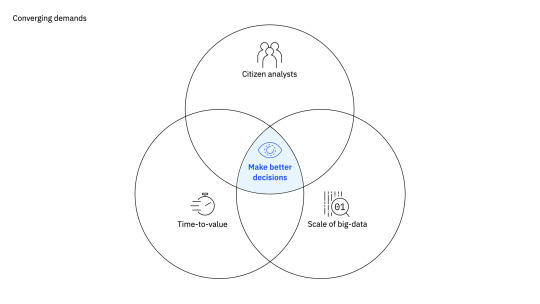
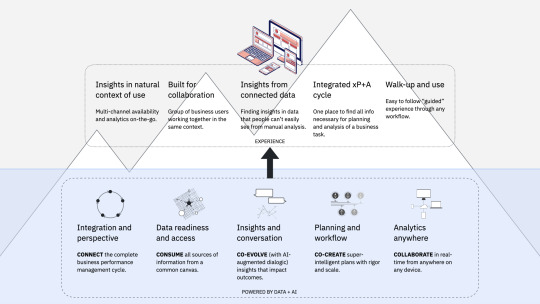
↑ Knowledge workers expect an xFPA experience considerably more approachable than existing systems, yet with the power to tap into deep organizational data.
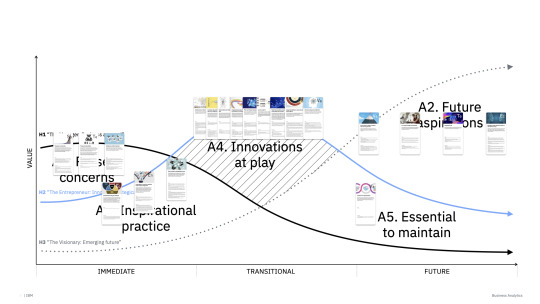
↑ The 3 Horizons foresight framework considers current, interim, and aspirational trajectories, which makes it particularly effective in business and enterprise contexts, where innovation has a polyrhythmic pattern.
↓ 19 relevant emerging trends and 5 key drivers were identified through horizon scanning and UX research data.
↘ Their impact on product trajectories was plotted together in a cross-functional workshop that included senior stakeholders from design, engineering, product management, sales, marketing, and research.

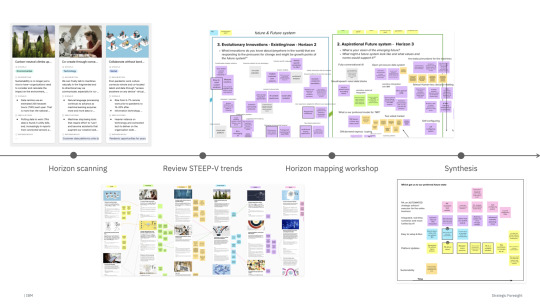
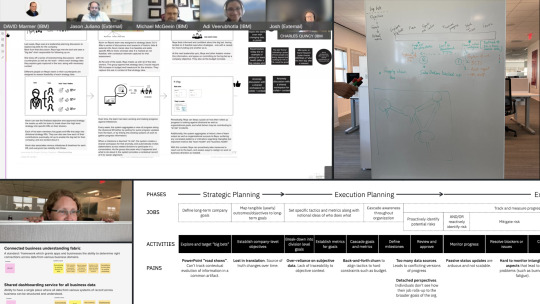
↑ Our envisioning sprints were a series of rapid collaborative design sessions in which we combined opportunities for under-served needs uncovered by Jobs-To-Be-Done, market and product analytics, and emerging technologies along 3 Horizons, to creatively envision use cases that could then be wind-tunneled and validated against our Value Proposition Canvas.
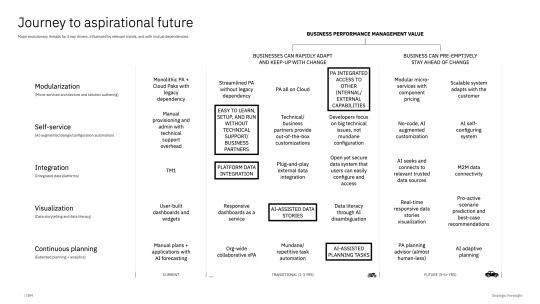
↑ New capabilities, and advances to existing ones, were proposed for near (skateboard), mid (bike), and long (car) development roadmaps.
↓ We identified current capabilities and technologies that would remain essential vs those that should eventually be deprecated.
↘ And anticipated tension points that require non-zero-sum strategies.
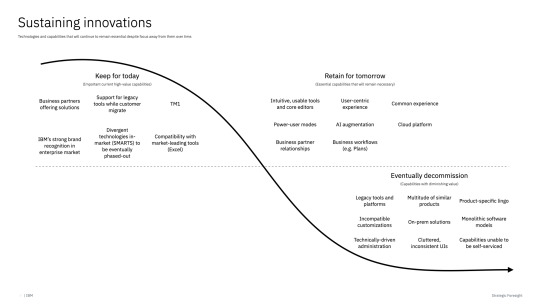
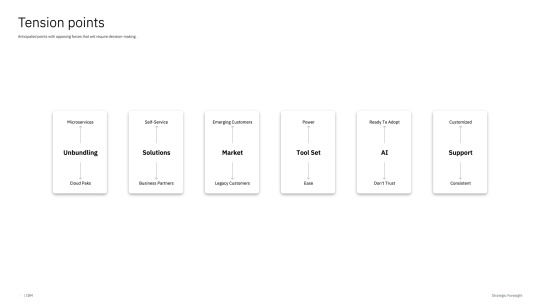

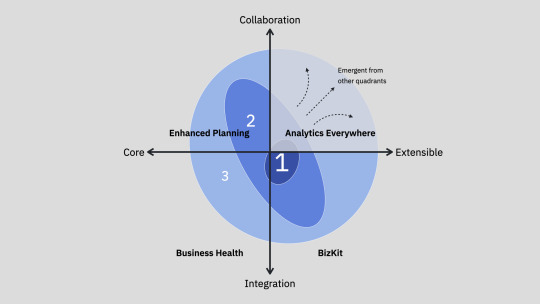
↑ Our product innovation strategy addressed 4 areas from core collaboration to an extended integration ecosystem.
↗ With a go-to-market in 3 phases, beginning with modularization of our products into a composable services architecture that can be connected in different ways to create an end-to-end business performance management cycle.
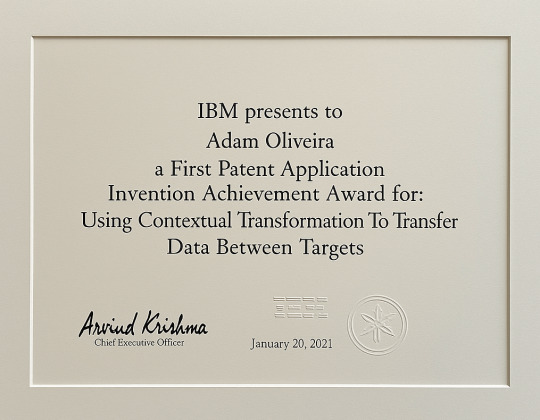
↑ An invention achievement for a patent I filed that addressed an interesting problem for users when working with common information across multiple applications in an integrated ecosystem. The patent proposes a method of copy-and-paste that uses AI to understand context of the transfer and modify the pasted content appropriately. For example, if copying and pasting data from one currency or language to another document in another currency or language.
↓ The patent was granted in 2021 and published in 2022. Read the full publication here »

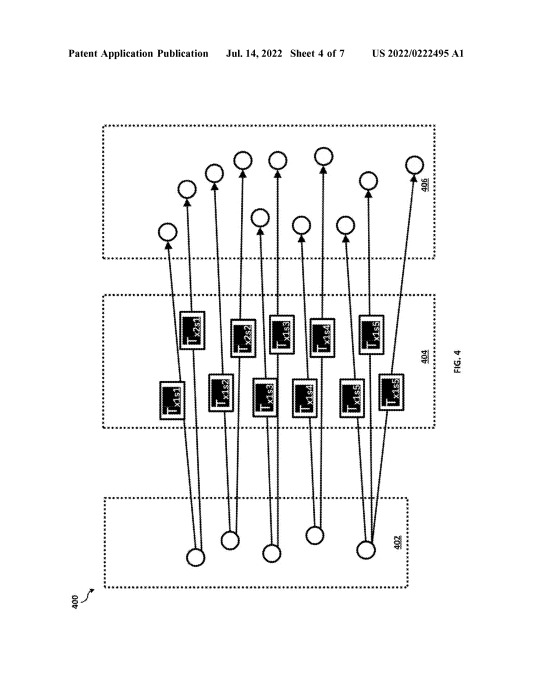
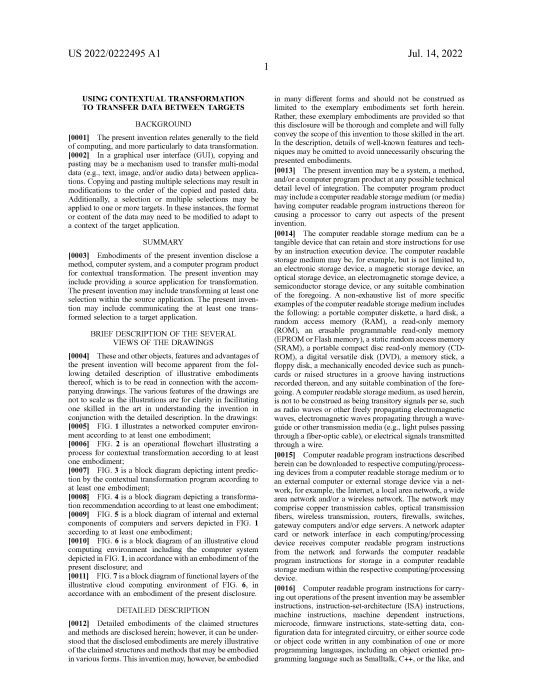
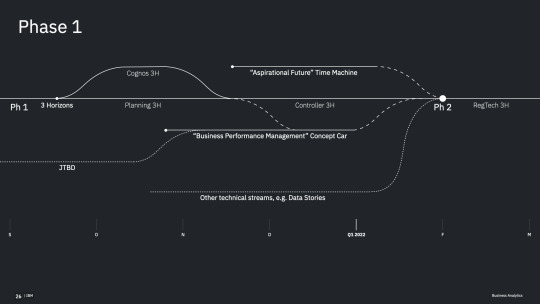
↑ The master plan involved conducting similar rigor on all 4 products, and converging existing streams of product development.
The strategic design work for reinventing IBM Business Analytics lead directly to the creation of the Advanced Product Design Group (APDG), and subsequently several new watsonx initiatives, including watsonx BI Assistant, which are covered in the next chapter on IBM Data + AI.
0 notes
Text

Dr. Evelyn Boyd Granville (May 1, 1924 - June 27, 2023) was the second African-American woman to receive a Ph.D. in mathematics from an American University; she earned it from Yale University. She performed pioneering work in the field of computing.
She entered Smith College. She majored in mathematics and physics but also took a keen interest in astronomy. She was elected to Phi Beta Kappa and Sigma Xi and graduated summa cum laude. Encouraged by a graduate scholarship from the Smith Student Aid Society of Smith College, she applied to graduate programs in mathematics and was accepted by both Yale University and the University of Michigan; she chose Yale because of the financial aid they offered. She studied functional analysis, finishing her doctorate. Her dissertation was “On Laguerre Series in the Complex Domain”.
She moved from Washington to New York City. She moved to Los Angeles. There she worked for the US Space Technology Laboratories, which became the North American Aviation Space and Information Systems Division. She worked on various projects for the Apollo program, including celestial mechanics, trajectory computation, and “digital computer techniques”.
Forced to move because of restructuring at IBM, she took a position at California State University, Los Angeles as a full professor of mathematics. After retiring from CSULA she taught at Texas College for four years and then joined the faculty of the University of Texas at Tyler as the Sam A. Lindsey Professor of Mathematics. There she developed elementary school math enrichment programs. She has remained a strong advocate for women’s education in tech. #africanhistory365 #africanexcellence #phibetakappa
8 notes
·
View notes
Text
Explore Canada’s Most In-Demand Courses for 2025!
Canada continues to be one of the top destinations for international students seeking abroad education—and with good reason. Its world-class universities, cutting-edge research facilities, multicultural environment, and student-friendly policies make it a magnet for learners worldwide. Over 900,000 international students enrolled in Canadian institutions last year, and the numbers are only expected to grow.

Whether you're planning to study in Canada to build a global career or to gain exposure to innovative learning, knowing which programs are most in demand can give you a competitive edge. These courses are aligned with market trends, global workforce demands, and Canada’s thriving industries.
Top Trending Courses in Canada for International Students
Engineering
Engineering remains a top pick for students aiming to study abroad. Canadian universities offer cutting-edge programs in disciplines such as mechanical, electrical, civil, and software engineering. The curriculum blends theory and hands-on learning, producing job-ready graduates.
Top recruiters: Aecon Group Inc., GHD Group, Canadian Natural Resources, Bantrel Co.
Computer Science & Information Technology
As digital innovation accelerates, tech professionals are more in demand than ever. Canada offers robust IT and computer science programs that train students in AI, data science, cybersecurity, and software development. These programs provide strong job prospects, especially in urban tech hubs like Toronto and Vancouver.
Top recruiters: Amazon, Deloitte Canada, IBM, Scotiabank
Nursing & Healthcare Management
With Canada’s aging population and growing healthcare needs, qualified nurses and healthcare managers are urgently needed. Degrees in these fields lead to high employability and meaningful careers focused on well-being and community care. Scholarships and financial aid are widely available to international students.
Top recruiters: Fraser Health, Medfall Group, McKesson, Vancouver Coastal Health
Architecture
Canada’s architectural education merges innovation with sustainability, incorporating Indigenous design principles and cutting-edge urban planning. Programs focus on eco-conscious design and livability, preparing students to shape future-friendly communities.
Top recruiters: Gensler, Arcadis, Sweco
Accounting & Finance
Finance professionals play a vital role in Canada's corporate landscape. Accounting and finance programs equip students with skills in investment, tax planning, auditing, and financial strategy. With a variety of diploma, undergraduate, and master's programs, students can find pathways that suit their career goals.
Top recruiters: RBC, TD Bank, Scotiabank
Business Administration & Management
Known for its stable economy and global business presence, Canada is ideal for students pursuing business studies. Courses emphasize leadership, marketing, entrepreneurship, and strategic decision-making. Many schools also offer co-op placements for real-world exposure.
Top recruiters: Bell, BC Hydro, BASF Canada, Accenture
Psychology & Counselling
Mental health and behavioral sciences are gaining increased recognition in Canada. Whether you're interested in therapy, education, or research, psychology graduates are in demand across the public and private sectors. Programs often include internships and placements in healthcare facilities.
Top recruiters: Alberta Health Services, Hamilton Health Sciences, Boston Consulting Group
Human Resource Management
Human Resources is a fast-growing sector in Canada, with top universities offering modern, hands-on HR programs. These courses develop skills in recruitment, performance management, labor laws, and workplace diversity. The strong industry-academic linkages increase job readiness.
Top recruiters: Amazon, RBC, Scotiabank
Project Management
Project management skills are essential across industries—from construction to IT and healthcare. Canadian institutions offer in-depth courses that cover leadership, budgeting, risk management, and team collaboration. Graduates are equipped to lead complex projects globally.
Top recruiters: Bell, IBM, CIBC, RBC
Logistics & Supply Chain Management
As global commerce expands, logistics and supply chain management have become mission-critical fields. Students learn to manage supply flows, optimize procurement, and improve warehouse and inventory systems. These programs open doors in retail, tech, and manufacturing sectors.
Top recruiters: AMZ Prep, Evolution Fulfillment, SHIPHYPE
Why Choose Canada for Higher Studies?
Canada’s education system is internationally respected, and its diverse, inclusive environment ensures you don’t just earn a degree—you build a future. Studying in Canada means access to globally recognized qualifications, high employability, and immigration pathways that allow graduates to stay and work.
Plan Your Canadian Education Journey with Confidence
If you're ready to take the next step toward a fulfilling international education experience, let the experts at Abroad Eduversity guide you. From choosing the right course and university to assisting with applications, visas, and scholarships, we handle every detail.
We are your trusted abroad education consultancy in Kolkata, helping students study in Canada, study in the UK, study in France, and beyond.
Let Abroad Eduversity turn your study abroad dream into reality.
0 notes
Text
Quantum Portfolio Optimizer: Global Data Quantum, IBM Qiskit

Portfolio optimisation for quantum computing
Global Data Quantum introduced the Quantum Portfolio Optimiser function in IBM Qiskit. Quantum computing optimises investment portfolios.
A detailed breakdown:
Quantum Portfolio Optimiser Goal
The Quantum Portfolio Optimiser optimises investment performance while reducing transaction costs and risks. Its dynamic portfolio optimisation goal is to find the optimum investment plan across many time periods to maximise projected return and minimise risks, often while considering budget, transaction costs, and risk aversion. Dynamic portfolio optimisation modifies assets based on asset performance, unlike traditional portfolio optimisation, which uses a single rebalancing time. The program targets analysts, investors, and portfolio managers. Portfolio optimisation allows backtesting trading approaches.
Quantum Portfolio Optimiser Access:
Discover the function in IBM Qiskit Functions Catalogue. This experimental functionality is only available to IBM Quantum Premium and Flex Plan users in preview release. Request a catalogue to access Global Data Quantum.
Quantum Computing—Why?
Traditional methods become slow and inefficient as resources or limits increase. Quantum computing's capacity to analyse several variables in parallel can solve complex problems faster and more efficiently than classical solvers like CPLEX, Gurobi, and Pyscf on HPC resources.
Quantum Portfolio Optimiser Functions?
The Quantum Portfolio Optimiser has four steps:
It receives financial asset values and user-specified investing conditions.
Quantum circuits convert classical input data into a quantum-resolution problem. This requires constructing the dynamic portfolio optimisation problem using Quadratic Unconstrained Binary optimisation (QUBO) and converting it into a quantum operator (Ising Hamiltonian).
The Variational Quantum Eigensolver (VQE) algorithm is considered. The VQE was designed to determine the optimal solution-wide investment combinations. In this hybrid quantum-classical approach, the quantum circuit estimates the cost function and Differential Evolution is used for classical optimisation.
Adjusting post-processing to eliminate quantum device noise yields an optimal, trustworthy, and realistic recommendation. For optimal output, the system uses noise-aware (SQD-based) post-processing.
Formulating Problems
Portfolio optimisation uses multi-objective Quadratic Unconstrained Binary Optimisation (QUBO). The QUBO function optimises four goals:
Max out the return function (F).
Reduce investment risk (R) and transaction costs.
Respect investment limits. The QUBO function is defined as O = -F + (γ/2)R + C + ρP, where γ is the risk aversion coefficient and ρ is the constraints reinforcement coefficient (Lagrange multiplier The minimum qubit count for a problem is the number of assets (na), time periods (nt), and bit resolution (nq) used to describe the investment.
Input
This function requires several input parameters:
A dictionary of asset prices uses dates as supplementary keys. All assets must have consistent data for the same dates.
Qubo_settings: A dictionary that configures the QUBO problem with parameters like nq resolution qubits, dt time window each step, maximum investment per asset, risk aversion coefficient, transaction charge, and restriction coefficient.
Optimizer_settings (Optional): Sets up the standard optimisation technique, including primitive settings (sampler_shots, estimator_shots) and differentiation_evolution algorithm parameters (num_generations, population_size).
ansatz_settings (Optional): Select “optimized_real_amplitudes” or “tailored” and enable multiple pass managers, dynamical decoupling, and other options to configure the quantum circuit ansatz.
Optional: QPU backend name, such as “ibm_torino.”
previous_session_id (Optional): A list of past session IDs to continue execution or retrieve data.
Apply_postprocess (Optional): True applies noise-aware SQD post-processing.
tags: An optional text list to label the experiment.
Output
Function returns two dictionaries: “result” and “metadata”.
Result: optimal optimisation outcomes, such as the optimal investment strategy over time and the lowest target cost. Investment weights are normalised by total investment.
Metadata: Metadata describes all optimisation results. It includes counts, investment pathways, objective costs, Sharpe ratios, returns, limitation violations, samples/states, and transaction costs. The session ID, asset order, QUBO matrix, and resource consumption summary are all included. Return, Sharpe ratio, restriction deviation, and least objective cost are key metadata for the best solution.
Application Function Context Qiskit
Application functions like the Quantum Portfolio Optimiser provide a comprehensive quantum pipeline by abstracting the quantum workflow. Because quantum methods use conventional classical inputs and return domain-familiar classical outputs, they can be easily integrated into present application processes without quantum computing knowledge.
Analysis of Performance and Benchmarks
The function is verified using different resolution qubit, ansatz circuit, and asset grouping configurations. Benchmarks evaluate solutions using two metrics:
Objective cost: To evaluate optimisation, the objective cost compares the cost function value to Gurobi (free version) output.
Sharpe ratio: Measures portfolio risk-adjusted return. Benchmark data shows the quantum optimiser finds viable investment plans. For a test using IBEX35 assets (Set 3, 4 time steps, 2-bit encoding, 56 qubits), the Optimised Real Amplitudes ansatz had an objective cost of -3.67 and a Sharpe ratio of 14.48, while Gurobi had 16.44 and -4.11. Comparing quantum sampling to random sampling, visual inspection shows that lower prices dominate the distribution.
#QuantumPortfolioOptimizer#QuantumPortfolio#GlobalDataQuantum#QuadraticUnconstrainedBinaryOptimisation#VariationalQuantumEigensolver#PortfolioOptimizer#technology#technews#technologynews#news#govindhtech
0 notes
Text
Service Integration and Management Market Size, Share, Trends, Growth Opportunities and Competitive Outlook
Service Integration and Management Market - Size, Share, Demand, Industry Trends and Opportunities
Global Service Integration and Management Market, By Component (Solution, Services), Organization Size (Small and Medium-Sized Enterprises, Large Enterprises), Vertical (IT and Telecommunications, Banking, Financial Services And Insurance, Retail, Manufacturing, Energy And Utilities, Transportation, Logistics, Others), Country (U.S., Canada, Mexico, Brazil, Argentina, Rest of South America, Germany, Italy, U.K., France, Spain, Netherlands, Belgium, Switzerland, Turkey, Russia, Rest of Europe, Japan, China, India, South Korea, Australia, Singapore, Malaysia, Thailand, Indonesia, Philippines, Rest of Asia-Pacific, Saudi Arabia, U.A.E, South Africa, Egypt, Israel, Rest of Middle East and Africa) Industry Trends
Access Full 350 Pages PDF Report @
The Service Integration and Management (SIAM) Market is experiencing significant growth due to the increasing demand for managing multiple service providers efficiently. SIAM frameworks help organizations streamline their services by integrating various service providers to deliver a unified service to end-users. Factors such as the need for enhanced service quality, cost-effectiveness, and improved customer satisfaction are driving the growth of the SIAM market. Additionally, the rising adoption of cloud-based solutions and the proliferation of digital transformation initiatives across industries are contributing to the market expansion.
**Segments**
- **By Component:** This segment includes solutions and services. The solutions segment is further categorized into business solutions, technology solutions, and tools. The services segment consists of consulting, implementation, and training services.
- **By Deployment Model:** The market is segmented into on-premises and cloud-based deployment models. Organizations can choose the deployment model based on their specific requirements such as scalability, security, and ease of maintenance.
- **By Organization Size:** Small and Medium-sized Enterprises (SMEs) and Large Enterprises are the two categories under this segment. SMEs are increasingly adopting SIAM solutions to enhance their operational efficiency and competitiveness in the market.
- **By Vertical:** Various industry verticals such as IT & Telecom, BFSI, Healthcare, Retail, and others are utilizing SIAM frameworks to streamline their service delivery processes and improve overall business performance.
**Market Players**
- Accenture plc - Capgemini - HCL Technologies Limited - Tata Consultancy Services Limited - IBM Corporation - DXC Technology Company - Atos SE - Wipro Limited - Fujitsu - Mindtree
These market players are actively involved in strategic initiatives such as partnerships, collaborations, acquisitions, and product developments to strengthen their market position and gain a competitive edge. They are focusing on enhancing their service offerings to cater to the evolving needs of customers across various industry verticals. The intense competition among key players is leading to innovations in SIAM solutionsThe Service Integration and Management (SIAM) market is witnessing robust growth driven by the increasing demand for effective management of multiple service providers. Organizations are increasingly adopting SIAM frameworks to streamline their services and deliver a unified experience to end-users. The need for improved service quality, cost-efficiency, and enhanced customer satisfaction is propelling the expansion of the SIAM market. Moreover, the rapid adoption of cloud-based solutions and the escalating digital transformation initiatives across various industries are further fueling market growth.
In terms of segmentation, the SIAM market can be categorized based on components, deployment models, organization sizes, and verticals. The component segment includes solutions and services, with solutions subcategorized into business solutions, technology solutions, and tools. The services segment comprises consulting, implementation, and training services. Organization size segmentation includes Small and Medium-sized Enterprises (SMEs) and Large Enterprises. SMEs are increasingly turning to SIAM solutions to boost operational efficiency and competitiveness. On the other hand, the vertical segment encompasses industries such as IT & Telecom, BFSI, Healthcare, Retail, among others, leveraging SIAM frameworks to streamline service delivery processes and enhance overall business performance.
Key market players in the SIAM industry include Accenture plc, Capgemini, HCL Technologies Limited, Tata Consultancy Services Limited, IBM Corporation, DXC Technology Company, Atos SE, Wipro Limited, Fujitsu, and Mindtree. These market players are actively engaging in strategic initiatives such as partnerships, collaborations, acquisitions, and product developments to fortify their market positions and stay ahead in the competitive landscape. By enhancing their service offerings, these companies are catering to the evolving needs of customers across diverse industry verticals. The competitive dynamics among these key players are fostering innovations in SIAM solutions, leading to the continuous evolution of the market landscape.
Looking ahead, the SIAM market is poised for further growth as organizations continue to prioritize efficient service management and seek ways to enhance customer experience. With the relentless digital transformation wave**Global Service Integration and Management Market**
- **By Component:** The market is segmented into solutions and services. Solutions are further categorized into business solutions, technology solutions, and tools. Services encompass consulting, implementation, and training services.
- **By Organization Size:** Small and Medium-Sized Enterprises (SMEs) and Large Enterprises are the two segments under this category. SMEs are increasingly adopting SIAM solutions to boost operational efficiency.
- **By Vertical:** Industry verticals such as IT & Telecommunications, Banking & Financial Services, Retail, Manufacturing, Energy & Utilities, Transportation & Logistics, among others, are leveraging SIAM frameworks to streamline service delivery processes and enhance overall business performance.
The Global Service Integration and Management Market is witnessing significant growth propelled by the increasing demand for managing multiple service providers effectively. Organizations are turning to SIAM frameworks to streamline services and provide a seamless experience to end-users. The market expansion is being primarily driven by the need for improved service quality, cost-efficiency, and enhanced customer satisfaction. Additionally, the rapid adoption of cloud-based solutions and the escalating digital transformation initiatives across various industries are further fueling market growth.
Market players in the SIAM industry are actively engaging in strategic initiatives such as partnerships, collaborations, acquisitions, and product developments to strengthen their market positions and remain competitive. Key players like Accenture plc, Capgemini, HCL Technologies Limited, Tata Consultancy Services Limited, IBM Corporation, and others, are continuously enhancing their service offerings to meet
Service Integration and Management Key Benefits over Global Competitors:
The report provides a qualitative and quantitative analysis of the Service Integration and Management Market trends, forecasts, and market size to determine new opportunities.
Porter’s Five Forces analysis highlights the potency of buyers and suppliers to enable stakeholders to make strategic business decisions and determine the level of competition in the industry.
Top impacting factors & major investment pockets are highlighted in the research.
The major countries in each region are analyzed and their revenue contribution is mentioned.
The market player positioning segment provides an understanding of the current position of the market players active in the Personal Care Ingredients
Table of Contents: Service Integration and Management Market
1 Introduction
2 Global Service Integration and Management Market Segmentation
3 Executive Summary
4 Premium Insight
5 Market Overview
6 Service Integration and Management Market, by Product Type
7 Service Integration and Management Market, by Modality
8 Service Integration and Management Market, by Type
9 Service Integration and Management Market, by Mode
10 Service Integration and Management Market, by End User
12 Service Integration and Management Market, by Geography
12 Service Integration and Management Market, Company Landscape
13 Swot Analysis
14 Company Profiles
Critical Insights Related to the Keyword Included in the Report:
Exclusive graphics and Illustrative Porter’s Five Forces analysis of some of the leading companies in this market
Value chain analysis of prominent players in the market
Current trends influencing the dynamics of this market across various geographies
Recent mergers, acquisitions, collaborations, and partnerships
Revenue growth of this industry over the forecast period
Marketing strategy study and growth trends
Growth-driven factor analysis
Emerging recess segments and region-wise market
An empirical evaluation of the curve of this market
Ancient, Present, and Probable scope of the market from both prospect value and volume
Browse Trending Reports:
Personal Care Contract Manufacturing Market Sleep Tech Devices Market Hemiballismus Treatment Market Bio Based Leather Market Autorefractor keratometer Device Market Oil Shale Market Cyclin-dependent Kinase Inhibitor Market Automated Harvesting System Market Aluminium Nitride Market Trauma Devices Market Self-Storage and Moving Services Market Tetracyclines Market
About Data Bridge Market Research:
Data Bridge set forth itself as an unconventional and neoteric Market research and consulting firm with unparalleled level of resilience and integrated approaches. We are determined to unearth the best market opportunities and foster efficient information for your business to thrive in the market. Data Bridge endeavors to provide appropriate solutions to the complex business challenges and initiates an effortless decision-making process.
Contact Us:
Data Bridge Market Research
US: +1 614 591 3140
UK: +44 845 154 9652
APAC : +653 1251 975
Email: [email protected]
0 notes
Text
ACCA考试科目以及在中国的用途,ACCA替考远程找人代考
ACCA适用于英国会计准则和国际会计准则,IBM、GE、摩托罗拉、强生、卡特彼勒、”四大”等国内外企业均认可ACCA证书。ACCA在普通中资企业中的认可度确实低于中国注册会计师,但实际差别并不大,而且大多数ACCA学员毕业后并不会进入普通中资企业,多数是知名中资企业或外资企业。目前ACCA中国区认可雇主超过500家,已涵盖了所有的著名中资企业,至于外资企业,ACCA的认可度更是远高于中国注册会计师。
但是ACCA考试科目多,共有14门考试科目,分为两个部分:第一部分为基础阶段,共9门,主要涉及财务会计和管理会计方面的核心知识:
F1Accountant in Business 商业会计,F2 Management Accounting 管理会计,F3 Financial Accounting 财务会计,F4 Corporate and Business Law 公司法,F5 Performance Management 绩效管理,F6 Taxation 税务,F7 Financial Reporting 财务报告,F8 Audit and Assurance 审计及鉴证,F9 Financial Management 财务管理
第二部分为专业阶段,四选二,P4—P7任选两门进行考试:ACCA SBL-战略商业领袖,SBR战略商业报告,P4 Advanced Financial Management 高级财务管理,P5 Advanced Performance Management 高级绩效管理,P6 Advanced Taxation 高级税收,P7 Advanced Audit and Assurance 高级审计及鉴证
近年来,为吸引和培养国际化高端财会人才,不少地方注册会计师协会纷纷将ACCA纳入行业发展专项基金的奖励范畴,为ACCA人才提供数额可观的现金奖励。除了注协,不少地方政府也纷纷把ACCA纳入紧缺人才目录、高端金融人才发展规划之中,给与不同程度的财政支持和福利待遇。ACCA每年的活动汇集了国内一线经济学家、行业领袖、知名学者,成为财会界引领行业话题的标杆。活动内容既包含税务、财报、企业融资、资本市场等专业硬知识,又为职场新人、中层管理者、高层领导者以及有职业转型需求人士,为国企民企外企等不同企业员工,不同行业在职人士,提供从行业洞察到职场软技能等专业讲座。
关于签字权,实际上只有在会计师事务所工作时签字权才能派上用场,而签字权也并不是每一个审计人员都需要的,一个事务所有两个人有签字权就够了。会计师事务所更看重的是个人专业能力,而不是签字权。ACCA与国内外优秀商学院强强联手,推出专属项目及奖学金计划,汇集众多优质学习资源及平台支持,满足会员终身职业发展的需求。如:伦敦大学专业会计硕士项目,牛津布鲁克斯大学MBA项目,中欧FMBA-ACCA专项奖学金计划等。
ACCA替考,ACCA代考,ACCA找人考试,ACCA找枪手,ACCA在家考试,ACCA线上考试,ACCA线下考试,ACCA线上替考,ACCA线上代考,ACCA线上保过,ACCA线上助考
V: Acc_genius
0 notes